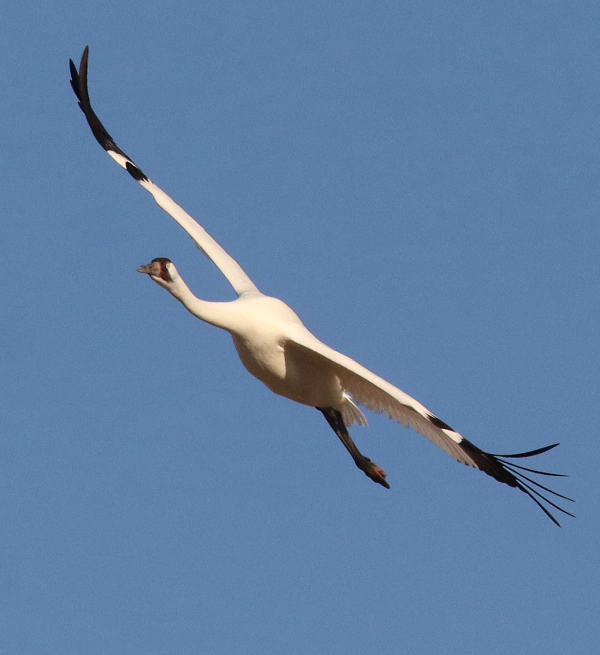
The week was filled with more Whooping Crane excitement, including the opportunity to photograph some of the grand birds during their extended migration stopover.
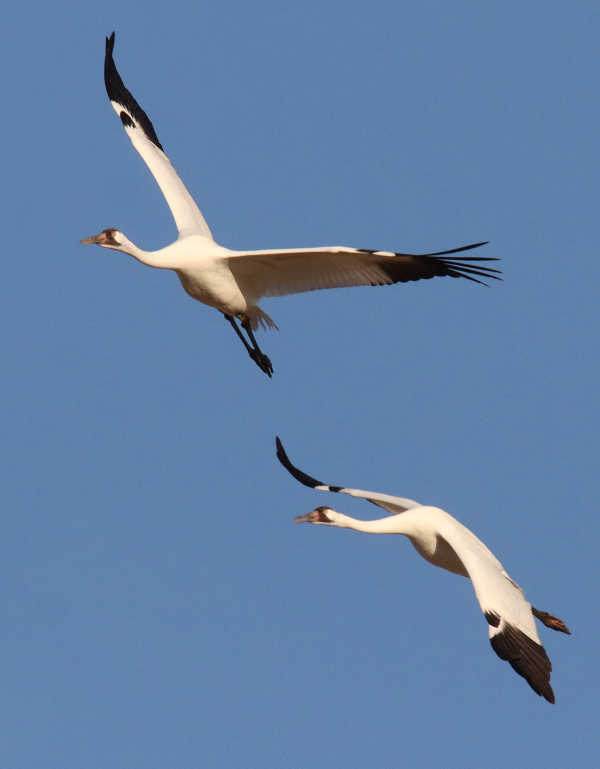
The excitement of observing, hearing, and photographing Whooping Cranes, with as many as 38 in a marsh adjacent to the Missouri River, has been an exceptional highlight of this fall migration period.
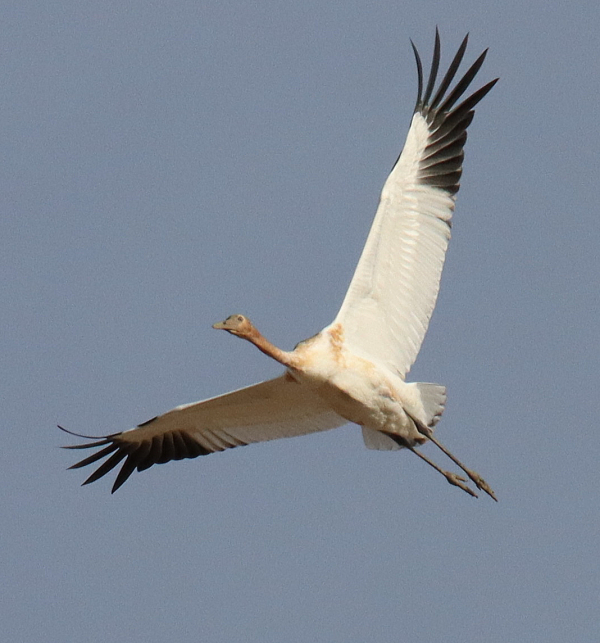
An interesting photograph of one of the young Whoopers shows it has a very muddy beak, face, and feet, which indicates it has been digging in gray mud for plant tubers or small animals.
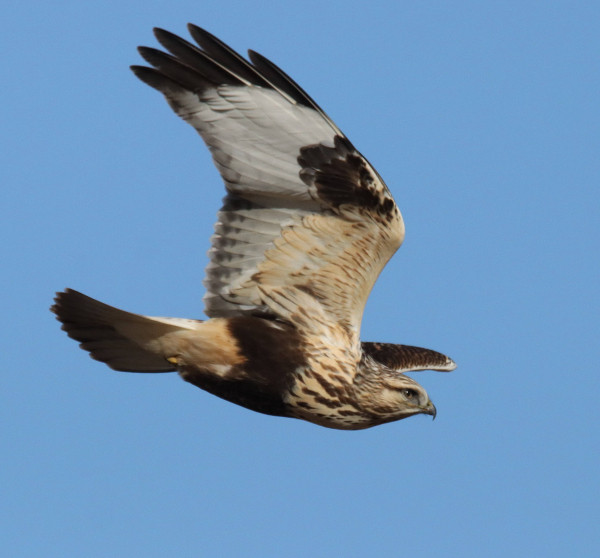
Recently arrived from its Arctic summer range, a Rough-legged Hawk dives toward a small rodent in short grass.
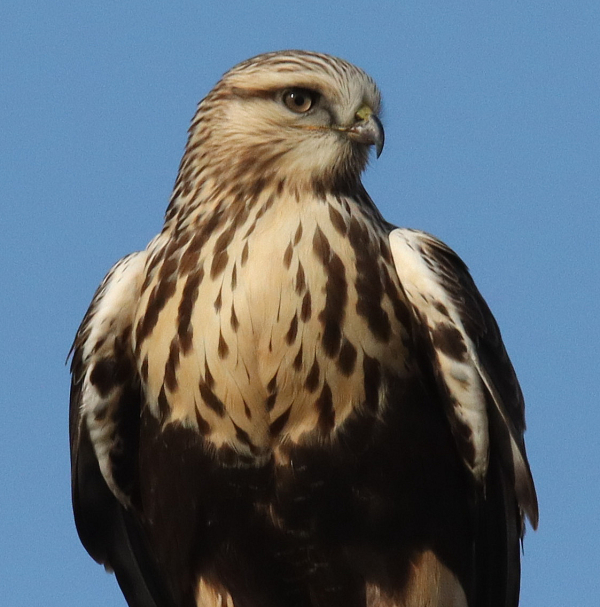
The same Rough-legged Hawk provided a close portrait photo that shows its comparatively small beak, by far the smallest among the Buteo hawks and an adaptation for hunting small rodents – voles, mice, and lemmings.
|
After climbing a high bluff on the east side of the Missouri River, I stood on the edge of an 80-foot cliff to count 28 Whooping Cranes in the shallows below, which was 12 more than 2 days before (last Tuesday). Suddenly 10 more Whoopers winged into sight from the shore; there were 38 total, including 4 family groups, each consisting of a pair with a single young crane making the long migration the first time. I monitored the cranes’ numbers and movements from the river to feeding sites and back during parts of 4 of the previous 5 days, and with sunshine predicted for Friday, I knew I’d be back – Whooping Cranes will do that to a guy like me.
How many Whoopers would be on hand Friday? I counted 11 initially, then 6 more, for a total of 17, but as I was leaving there was a flock of 11 Whooping Cranes feeding in the field where I had a flock of 11 Monday – were they part of the 17 on hand a little farther north? Or were they the 11 that I saw in that field Monday, separate from the 17? Hmm. Regardless, 17 or 28, I had a couple remarkable experiences with some trusting Whooping Cranes again Thursday and Friday.
Perhaps the most memorable of them all was when a flock of 5, including a young one, flew from their roosting marsh toward their usual feeding field – a harvested cornfield. I was positioned along a preferred flight path between the roost site and the field with the sun at my back. The cranes flew low along the route I hoped they would take, providing an opportunity to photograph them broadside as they flew into an ever-better angle of sunlight.
They continued to fly above the cornfield as usual, circling; but then they began rising up as they circled – they began soaring. And as they soared, they were making their way ever-closer in my direction, until they were directly overhead! That’s when they began calling, and I can’t fully explain what it felt like to have these super-rare mega-birds soaring with fully spread wings, circling above me and trumpeting calls into the Missouri River Valley – WoWza!! Who wouldn’t feel a personal connection to this event and these birds?
Thursday’s best photo opportunity was similar to several others; repeatedly, after the Whooping Cranes finish feeding, they take flight into the wind, turn, and fly directly toward me. I focus on them while they are still a distance away, and begin photographing as they fly closer. Invariably, the flock turns left as individuals fill my camera’s viewfinder, thereby receiving the full effect of the afternoon sunshine – the most beautiful light to have when photographing birds in flight. To have one such opportunity to observe and photograph Whooping Cranes would be precious, but I’ve had similar interactions with the cranes throughout the week – what great luck!
Missouri Valley Birding
Of course, there are other birds on hand too. Thursday and Friday the Whooping Cranes associated with a concentration of about 250 Sandhill Cranes, and both afternoons the only 2 North American crane species roosted in a large shallow marsh fed by the river and runoff. After mid-afternoon the cranes began taking flight, flock after flock, to reach the cornfield where they fed until sunset. There are small flocks of Canada and Cackling Geese that also feed near the cranes, as do Mallards some afternoons. Along the edges of the field are many Ring-necked Pheasants and Sharp-tailed Grouse, and an occasional Northern Shrike, Blue Jay, or American Robin.
Bald Eagles also migrate along the riverside, and Thursday I observed 4 immatures and an adult in transit, along with a Red-tailed Hawk and 2 Rough-legged Hawks. In addition, about 5 miles south, I encountered 3 Golden Eagles in flight along the edges of a couple high buttes. The first Golden appeared as I topped the butte via the roadway and it was flying low along the backside of the steep slope. I stopped and began photographing its progress as it flew across the road and relayed to the next butte, and that’s when I realized another Golden Eagle was flying to within a few feet of the first. I followed the duo’s flight as they flew toward one another and circled in a playful way, until a third Golden met them in flight! Golden Eagles are relatively uncommon in the region, except that the Missouri Slope is used as a migration corridor for birds of prey, waterfowl, cranes, and other birds.
Along 1 of the 2 100-mile routes I drive between my office and the Whooping Crane stopover area, there are a number of excellent locations I can monitor for migrating geese, swans, and ducks – mostly along the 65 miles closer to my office. Five wetlands are best to observe Tundra Swans now, with more than 100 found at 4 of these and about 65 at the fifth. Large concentrations of geese numbering more than 2,000, primarily Snow Geese, are obvious on 4 different lakes, including 1 flock just a mile north of my office where there are plenty of White-fronted Geese too. During each of my Whooping Crane drives there are 1 or 2 Rough-legged Hawks, Red-tailed Hawks, and Bald Eagles too – and I even had a Cooper’s Hawk sighting last Thursday.
Homestead Action
Although American Goldfinches seem to have vanished from my feeders by Monday, with Pine Siskins were scarce too, there was a male Purple Finch on hand Friday, and a female Purple Finch appeared Saturday. A male Hairy Woodpecker that could be a second male is distinct from earlier ones by its behavior of feeding in the platform feeder on shelled peanut halves and shelled black oil sunflower seeds rather than feeding on suet as the others did. At least 4 Blue Jays continue to hoard seeds and peanut halves, providing little thrills when they appear.
With more geese arriving, flocks fly over my house daily now, adding goose music to the area that I can hear even when I’m working indoors. By Monday afternoon it seemed the main flock that centers at Dean’s Lake, a mile northeast of home, had doubled in size; and it was interesting to see the geese using at least 3 different feeding fields, all located within 3 miles of home. Even if there are 4,000 Snow Geese on hand now, that number should increase by 10 times soon, and by more than 100 times before freeze-up, so there is a lot of waterfowl action still on the horizon this November. It's an exciting time of fall that I hope you can take full advantage of in your neighborhood and state. Think big, plan a birding trip, maybe over Thanksgiving holiday; and always appreciate the birds that you attract to your home turf. Good Birding!
Article and Photos by Paul Konrad
Share your bird sightings and photographs at editorstbw2@gmail.com